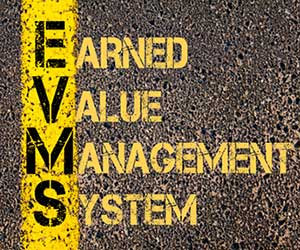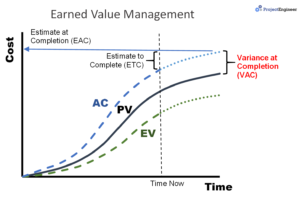
The VAC is a forecast of what the variance, specifically the Cost Variance (CV), will be upon the completion of the project. It is the size of the expected cost overrun or underrun. In many situations the project manager must request additional funding as early as possible, or at least report the potential for an overrun. The VAC represents the size of this request.
VAC Formula
The formula is:
= Old Budget – New Budget
Interpretation
The VAC represents the amount of expected budget overrun or underrun at the end of the project.
It should not be confused with the budget underrun or overrun today. That’s the Cost Variance (CV). Rather, it is a projection which assumes that whatever conditions caused a the variance position today will result in a variance position in the future.
The Variance at Completion is simply a future projected Cost Variance (CV). It has the same units as CV. It is the same type of element.
Sample PMP Exam Questions
- A project has a budget of $250,000. The estimated final cost to complete the project is $275,000. What is the Variance at Completion (VAC)?
VAC = BAC – EAC
= $250,000 – $275,000
= -$25,000 - If the Cost Variance (CV) of a project is positive, would the Variance at Completion (VAC) be positive or negative?
Positive, because the CV represents the current budget status, and the VAC indicates the final outcome under the current trend.
Earned Value Metrics
Variance at Completion is one of 12 earned value metrics which are calculated in the following three categories:
Planning
- BAC (Budget at Completion): The project budget.
- PV (Planned Value): The expected current budget and schedule completion.
- EV (Earned Value): The actual current budget and schedule completion.
- AC (Actual Cost): The actual amount of funds spent on the project.
Current Status
- SV (Schedule Variance): How far ahead or behind schedule the project is.
- SPI (Schedule Performance Index): How far ahead or behind schedule the project is, expressed as a percentage of the overall project duration.
- CV (Cost Variance): How far over or under budget the project is.
- CPI (Cost Performance Index): How far over or under budget the project is, expressed as a percentage of the overall project budget.

Future Projection
- ETC (Estimate to Complete): The amount of funds necessary to finish the project. This does not include funds spent to date.
- EAC (Estimate at Completion): The final project budget. This includes funds spent to date.
- VAC (Variance at Completion): The expected final Cost Variance (CV) assuming the efficiency level experienced throughout the project thus far.
- TCPI (To-Complete Performance Index): The Cost Performance Index (CPI) which must be achieved to allow the project to complete on budget.
VAC Example
We will once again add another column to the table:
| ID | Name | Start | End | BAC | PV | EV | AC | SV | SPI | CV | CPI | ETC | EAC | VAC |
|---|---|---|---|---|---|---|---|---|---|---|---|---|---|---|
| 100 | Plant Trees | July 1 | July 10 | $10,000 | $3,000 | $2,000 | $4,500 | -$1,000 | 0.67 | -$2,500 | 0.44 | $18,182 | $12,500 | -$2,500 |
After the VAC, the final variable will complete the table, TCPI. Then, the project manager must report the earned value results to the appropriate authorities.
For more information, visit our Earned Value Tutorial.






